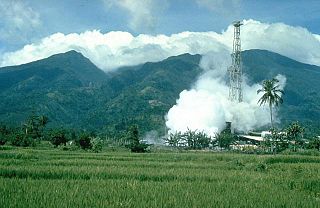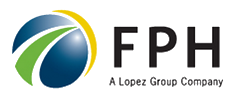
Geothermal energy is thermal energy extracted from the Earth's crust. It combines energy from the formation of the planet and from radioactive decay. Geothermal energy has been exploited as a source of heat and/or electric power for millennia.

Mount Apo is the highest mountain peak in the Philippines, with an elevation of 2,954 meters (9,692 ft) above sea level. A large solfataric, dormant stratovolcano, it is part of the Apo-Talomo Mountain Range of Mindanao island. Apo is situated on the tripartite border of Davao City, Davao del Sur, and Cotabato; its peak is visible from Davao City 45 kilometers (28 mi) to the northeast, Digos 25 kilometers (16 mi) to the southeast, and Bansalan 20 kilometers (12 mi) to the west. Apo is a protected area and is the centerpiece of Mount Apo Natural Park.

The National Power Corporation is a Philippine government-owned and controlled corporation that is mandated to provide electricity to all rural areas of the Philippines by 2025, to manage water resources for power generation, and to optimize the use of other power generating assets.

Ambuklao Dam is part of a hydroelectric facility in Baragay Ambuclao, Bokod, Benguet province in the Philippines. With a maximum water storage capacity of 327,170,000 cubic metres (265,240 acre⋅ft), the facility, which is located 36 km (22 mi) from Baguio, can produce up to 105 megawatts of electricity for the Luzon grid. The main source of water is the Agno River, which originates from Mount Data. The dam is located in a conservation area known as the Upper Agno River Basin Resource Reserve.

Magat Dam is a large rock-fill dam in the island of Luzon in the Philippines. The dam is located along the Magat River, a major tributary of the Cagayan River. The construction of the dam started in 1975 and was completed in 1982. It is one of the largest dams in the Philippines. It is a multi-purpose dam which is used primarily for irrigating about 85,000 hectares of agricultural lands, flood control, and power generation through the Magat Hydroelectric Power Plant.

Mount Malinao is a potentially active stratovolcano located in the Bicol Region of the Philippines. The volcano displays strong fumarolic activity which is harnessed for generating electricity. Located on its slope is Tiwi Geothermal Power Plant, one of the first geothermal energy plant commissioned in the country.

Geothermal power in the Philippines is the country's second largest source of renewable energy, and the fifth largest source of energy overall. Among sources of renewable energy, it is second only to hydroelectric power, although both sources are surpassed by the amount of energy drawn from coal, oil, and natural gas in that order.

First Philippine Holdings Corporation (FPH) is a management and investment company whose major business is power generation and distribution, including strategic initiatives in manufacturing and property development. FPH is a member of the Lopez Group of Companies.

Jose Rene Dimataga Almendras is a Filipino businessman and public servant. He served as Secretary of the Department of Foreign Affairs in an acting capacity under the administration of President Benigno Aquino III. Prior to his appointment, Almendras held the position of Cabinet Secretary and Secretary of the Department of Energy.

Geothermal power in Indonesia is an increasingly significant source of renewable energy. As a result of its volcanic geology, it is often reported that Indonesia has 40% of the world's potential geothermal resources, estimated at 28,000 megawatts (MW).
Energy Development Corporation is the largest producer of geothermal energy in the Philippines and the second largest in the world. It is involved in alternative energy projects, including geothermal, hydroelectric and wind energy projects. The company was formerly owned by the Philippine National Oil Company, a state corporation owned by the Republic of the Philippines engaged in the exploration of resources, production of energy and distribution of power supply to smaller electricity distributor. EDC was privatized and acquired by the Lopez Group as part of its energy and power supply utility business units.
Energy in Serbia is dominated by fossil fuels, despite the public preference for renewable energy.

The electricity sector in the Philippines provides electricity through power generation, transmission, and distribution to many parts of the country. The Philippines is divided into three electrical grids, one each for Luzon, the Visayas and Mindanao. As of June 2016, the total installed capacity in the Philippines was 20,055 megawatts (MW), of which 14,348 MW was on the Luzon grid. As of June, 2016, the all-time peak demand on Luzon was 9,726 MW at 2:00 P.M. on May 2, 2016; on Visayas was 1,878 MW at 2:00 P.M. on May 11, 2016; and on Mindanao was 1,593 MW at 1:35 P.M. on June 8, 2016. However, about 12% of Filipinos have no access to electricity. The Philippines is also one of the countries in the world that has a fully functioning electricity market since 2006 called the Philippine Wholesale Electricity Spot Market(WESM) and is operated by an independent market operator.
In 2013, renewable energy provided 26.44% of the total electricity in the Philippines and 19,903 gigawatt-hours (GWh) of electrical energy out of a total demand of 75,266 gigawatt-hours. The Philippines is a net importer of fossil fuels. For the sake of energy security, there is momentum to develop renewable energy sources. The types available include hydropower, geothermal power, wind power, solar power and biomass power. The government of the Philippines has legislated a number of policies in order to increase the use of renewable energy by the country.
The Limay CCGT Power Plant is a 620-MW diesel-powered power station in Limay, Bataan, Philippines.

The Palinpinon Geothermal Power Plant is a 192.5-MW complex of geothermal power stations in Valencia, Negros Oriental, Philippines

The Makiling–Banahaw (Mak–Ban) Geothermal Power Plant is a 458-MW geothermal power station complex in Laguna and Batangas, Philippines.














